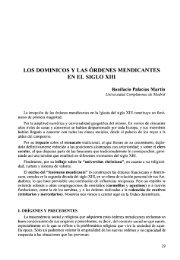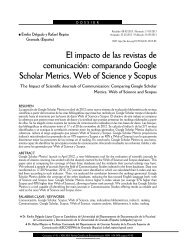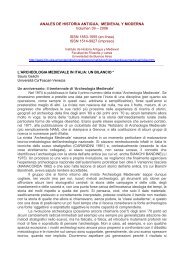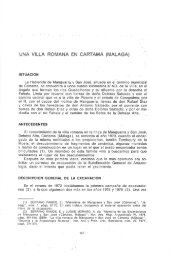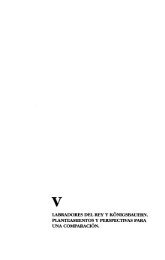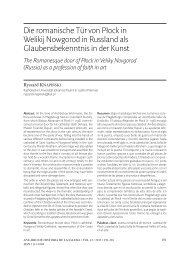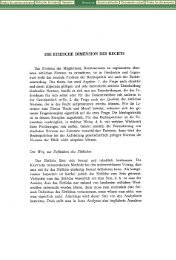Roslyn M. Frank 1.0. Introduction In the first chapter of this ... - Dialnet
Roslyn M. Frank 1.0. Introduction In the first chapter of this ... - Dialnet
Roslyn M. Frank 1.0. Introduction In the first chapter of this ... - Dialnet
You also want an ePaper? Increase the reach of your titles
YUMPU automatically turns print PDFs into web optimized ePapers that Google loves.
92 <strong>Roslyn</strong> M. <strong>Frank</strong><br />
mented belief among Basques that humans descended from bears. <strong>In</strong> addition, it<br />
was asserted that <strong>the</strong> name <strong>of</strong> <strong>the</strong> prototypical half-human, half-bear ancestor,<br />
called Hamalau in Euskera, provides a semantic anchor for exploring o<strong>the</strong>r cognitive<br />
artifacts belonging to <strong>this</strong> same cultural complex, one infused with <strong>the</strong><br />
belief in ursine ancestors, and a cosmology that clearly antedates any Neolithic<br />
mindset. Stated differently, I alleged that <strong>the</strong> animistic nature <strong>of</strong> <strong>this</strong> belief system<br />
where <strong>the</strong> identity <strong>of</strong> human beings is fused with that <strong>of</strong> bears harkens back<br />
to <strong>the</strong> mentality <strong>of</strong> hunter-ga<strong>the</strong>rers, and hence to <strong>the</strong> Mesolithic: it is not consonant<br />
with <strong>the</strong> mindset <strong>of</strong> a population <strong>of</strong> pastoral-agriculturalists. <strong>In</strong> <strong>this</strong> sense,<br />
<strong>the</strong> cognitive artifacts and social practices under analysis could date back ultimately<br />
to practices and beliefs <strong>of</strong> <strong>the</strong> hunter-ga<strong>the</strong>rers who inhabited <strong>the</strong> same<br />
zone in times past and whose ursine belief system was not entirely obliterated<br />
by <strong>the</strong> gradual imposition <strong>of</strong> <strong>the</strong> socio-cultural norms <strong>of</strong> a Neolithic pastoral<br />
and agriculturally-based society.<br />
<strong>In</strong> <strong>the</strong> final section <strong>of</strong> <strong>the</strong> previous study I pointed out <strong>the</strong> importance <strong>of</strong><br />
recent work in <strong>the</strong> field <strong>of</strong> molecular genetics dealing with <strong>the</strong> genetic makeup<br />
<strong>of</strong> populations <strong>of</strong> European descent, particularly investigations concerning <strong>the</strong><br />
frequencies <strong>of</strong> certain Y-chromosomes (which are transmitted through <strong>the</strong> male<br />
line) and mitochondrial DNA or mtDNA (which is transmitted through <strong>the</strong> female<br />
line). The results <strong>of</strong> <strong>the</strong>se research initiatives suggest that at <strong>the</strong> end <strong>of</strong> <strong>the</strong><br />
Last Glacial Maximum, <strong>the</strong>re was an expansion <strong>of</strong> populations out <strong>of</strong> <strong>the</strong><br />
Pyrenean-Cantabrian refugium. <strong>In</strong>vestigations carried out by teams <strong>of</strong> geneticists<br />
and archaeologists also indicate that <strong>the</strong>se groups gradually moved north<br />
and east to repopulate territory that had been depopulated during previous<br />
glaciations. For example, <strong>the</strong> patterns <strong>of</strong> repopulation proposed by Torroni et al.<br />
(1998: 1148) and based on <strong>the</strong> distribution <strong>of</strong> haplogroup V, radiate out <strong>of</strong> <strong>the</strong><br />
geographical zone defined as <strong>the</strong> Pyrenean-Cantabrian refugium. Here we shall<br />
use <strong>the</strong> term Palaeolithic Continuity Refugium Theory (PCRT) to refer to <strong>the</strong><br />
general approach developed by researchers who subscribe to <strong>this</strong> interpretation<br />
<strong>of</strong> <strong>the</strong> genetic and archaeological data.<br />
The limits <strong>of</strong> <strong>the</strong> refugium homeland, in turn, coincide closely with boundaries<br />
<strong>of</strong> <strong>the</strong> geographical extent <strong>of</strong> <strong>the</strong> historical Basque-speaking zone as best it<br />
can be reconstructed for <strong>the</strong> <strong>first</strong> century A.D. (Fig. 2).<br />
Upon closer examination, <strong>the</strong> map <strong>of</strong> Torroni et al. (1998:1148) implicates a<br />
larger geographical area than is suggested by <strong>the</strong> phraseology <strong>of</strong> <strong>the</strong> expression:<br />
Pyrenean-Cantabrian refugium. For <strong>this</strong> reason, our analysis will include representative<br />
samples <strong>of</strong> linguistic and ethnographic artifacts drawn from <strong>this</strong> larger<br />
geographic area. Stated differently, <strong>the</strong> area sampled should include Catalunya,



